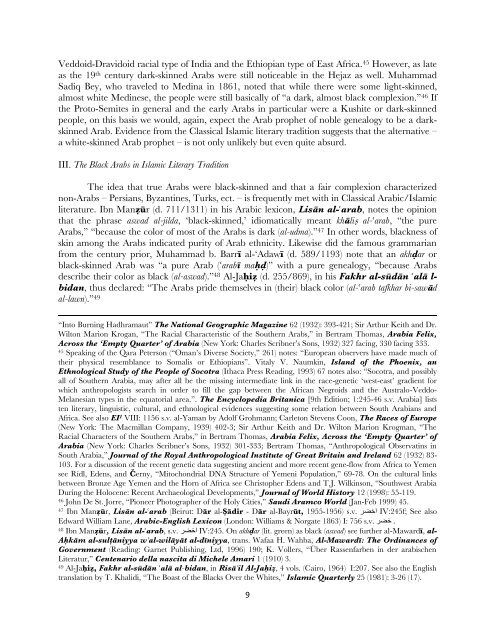Muhammad_Article.349.. - Dr. Wesley Muhammad
Muhammad_Article.349.. - Dr. Wesley Muhammad
Muhammad_Article.349.. - Dr. Wesley Muhammad
You also want an ePaper? Increase the reach of your titles
YUMPU automatically turns print PDFs into web optimized ePapers that Google loves.
Veddoid-<strong>Dr</strong>avidoid racial type of India and the Ethiopian type of East Africa. 45 However, as late<br />
as the 19 th century dark-skinned Arabs were still noticeable in the Hejaz as well. <strong>Muhammad</strong><br />
Sadiq Bey, who traveled to Medina in 1861, noted that while there were some light-skinned,<br />
almost white Medinese, the people were still basically of “a dark, almost black complexion.” 46 If<br />
the Proto-Semites in general and the early Arabs in particular were a Kushite or dark-skinned<br />
people, on this basis we would, again, expect the Arab prophet of noble genealogy to be a darkskinned<br />
Arab. Evidence from the Classical Islamic literary tradition suggests that the alternative –<br />
a white-skinned Arab prophet – is not only unlikely but even quite absurd.<br />
III. The Black Arabs in Islamic Literary Tradition<br />
The idea that true Arabs were black-skinned and that a fair complexion characterized<br />
non-Arabs – Persians, Byzantines, Turks, ect. – is frequently met with in Classical Arabic/Islamic<br />
literature. Ibn Maníår (d. 711/1311) in his Arabic lexicon, Lis§n al-#arab, notes the opinion<br />
that the phrase aswad al-jilda, ‘black-skinned,’ idiomatically meant kh§liß al-#arab, “the pure<br />
Arabs,” “because the color of most of the Arabs is dark (al-udma).” 47 In other words, blackness of<br />
skin among the Arabs indicated purity of Arab ethnicity. Likewise did the famous grammarian<br />
from the century prior, <strong>Muhammad</strong> b. BarrÊ al-‘AdawÊ (d. 589/1193) note that an akh∙ar or<br />
black-skinned Arab was “a pure Arab (#arabÊ maÈ∙)” with a pure genealogy, “because Arabs<br />
describe their color as black (al-aswad).” 48 Al-JaÈií (d. 255/869), in his Fakhr al-såd§n #al§ lbidan,<br />
thus declared: “The Arabs pride themselves in (their) black color (al-#arab tafkhar bi-saw§d<br />
al-lawn).” 49<br />
“Into Burning Hadhramaut” The National Geographic Magazine 62 (1932): 393-421; Sir Arthur Keith and <strong>Dr</strong>.<br />
Wilton Marion Krogan, “The Racial Characteristic of the Southern Arabs,” in Bertram Thomas, Arabia Felix,<br />
Across the ‘Empty Quarter’ of Arabia (New York: Charles Scribner’s Sons, 1932) 327 facing, 330 facing 333.<br />
45 Speaking of the Qara Peterson (“Oman’s Diverse Society,” 261) notes: “European observers have made much of<br />
their physical resemblance to Somalis or Ethiopians”. Vitaly V. Naumkin, Island of the Phoenix, an<br />
Ethnological Study of the People of Socotra (Ithaca Press Reading, 1993) 67 notes also: “Socotra, and possibly<br />
all of Southern Arabia, may after all be the missing intermediate link in the race-genetic ‘west-east’ gradient for<br />
which anthropologists search in order to fill the gap between the African Negroids and the Australo-Veddo-<br />
Melanesian types in the equatorial area.”. The Encyclopedia Britanica [9th Edition; 1:245-46 s.v. Arabia] lists<br />
ten literary, linguistic, cultural, and ethnological evidences suggesting some relation between South Arabians and<br />
Africa. See also EI 1 VIII: 1156 s.v. al-Yaman by Adolf Grohmann; Carleton Stevens Coon, The Races of Europe<br />
(New York: The Macmillan Company, 1939) 402-3; Sir Arthur Keith and <strong>Dr</strong>. Wilton Marion Krogman, “The<br />
Racial Characters of the Southern Arabs,” in Bertram Thomas, Arabia Felix, Across the ‘Empty Quarter’ of<br />
Arabia (New York: Charles Scribner’s Sons, 1932) 301-333; Bertram Thomas, “Anthropological Observatins in<br />
South Arabia,” Journal of the Royal Anthropological Institute of Great Britain and Ireland 62 (1932) 83-<br />
103. For a discussion of the recent genetic data suggesting ancient and more recent gene-flow from Africa to Yemen<br />
see Rídl, Edens, and 1erny, “Mitochondrial DNA Structure of Yemeni Population,” 69-78. On the cultural links<br />
between Bronze Age Yemen and the Horn of Africa see Christopher Edens and T.J. Wilkinson, “Southwest Arabia<br />
During the Holocene: Recent Archaeological Developments,” Journal of World History 12 (1998): 55-119.<br />
46 John De St. Jorre, “Pioneer Photographer of the Holy Cities,” Saudi Aramco World (Jan-Feb 1999) 45.<br />
47 Ibn Maníår, Lis§n al-#arab (Beirut: D§r al-‘§dir - D§r al-Bayråt, 1955-1956) s.v. رضخا IV:245f; See also<br />
Edward William Lane, Arabic-English Lexicon (London: Williams & Norgate 1863) I: 756 s.v. رضخ .<br />
48 Ibn Maníår, Lis§n al-#arab, s.v. رضخا IV:245. On akh∙ar (lit. green) as black (aswad) see further al-MawardÊ, al-<br />
AÈk§m al-sulã§niyya w"al-wil§y§t al-dÊniyya, trans. Wafaa H. Wahba, Al-MawardÊ: The Ordinances of<br />
Government (Reading: Garnet Publishing, Ltd, 1996) 190; K. Vollers, “Über Rassenfarben in der arabischen<br />
Literatur,” Centenario della nascita di Michele Amari 1 (1910) 3.<br />
49 Al-JaÈií, Fakhr al-såd§n #al§ al-bidan, in Ris§"il Al-JaÈií, 4 vols. (Cairo, 1964) I:207. See also the English<br />
translation by T. Khalidi, “The Boast of the Blacks Over the Whites,” Islamic Quarterly 25 (1981): 3-26 (17).<br />
9

















